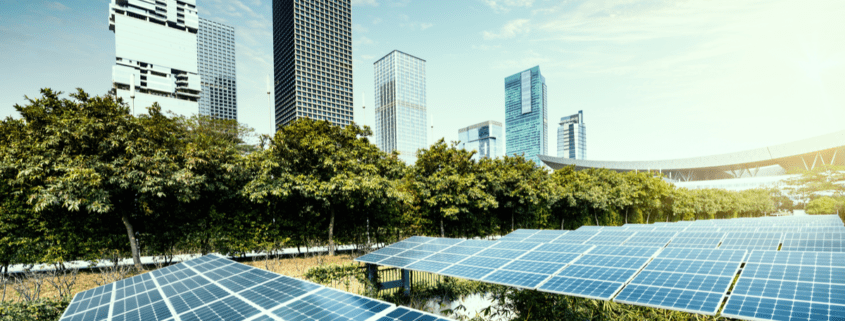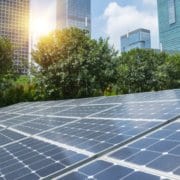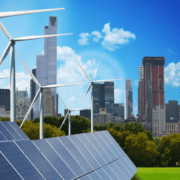3 Ways CRE Owners and Developers Can Attract Socially Responsible Investors
Socially responsible investors aim for strong financial performance, but also believe that their investments should be used to contribute to advancements in social, environmental and governance practices. Socially responsible investing is not new, but momentum is growing as investors demand action and increased transparency, and as the consequences grow for companies that fail to adapt. As a result, the environmentally conscious style of investing grew to more than $30 trillion in 2018 and is predicted to reach $50 trillion over the next two decades.
As investors become increasingly engaged with the concept of responsible investing, commercial real estate owners and developers should consider ways to create opportunities that will attract socially conscious investors. Fortunately, implementing energy-saving techniques and taking advantage of cleaner sources in a commercial building is easier today than ever before. For owners and developers, aligning their properties with today’s sustainability efforts not only boosts corporate image but also proves that owners and developers can be innovative and utilize green technology to achieve the overarching objective of carbon neutral –ultimately helping them attract socially responsible investors.
Reducing the Carbon Footprint
Today, commercial real estate properties account for nearly 1/5 of the total energy consumption in the United States. As much as 30% of that energy is being used either inefficiently or unnecessarily, indicating that there is indeed room for the industry to reduce its carbon footprint. Considering the amount of energy consumed by the commercial real estate industry alone, coupled with the Intergovernmental Panel on Climate Change’s (IPCC) prediction that we will experience a drastic climate change in about 14 years, socially responsible investors understand the importance of acknowledging the industry’s corporate social responsibility and are seeking opportunities to invest in properties with reduced footprints.
To attract investors, CRE owners and developers can reduce the carbon footprint by installing high-efficiency lighting, leveraging renewable energy, or incorporating HVAC systems. Additionally, they can begin planning for carbon footprint reduction as early in the development process as possible. A prime time to plan for this reduction is during the sourcing of building materials. Some examples of alternative methods for construction include using recycled goods to make materials, developing concrete that absorbs carbon dioxide, and even using algae for carbon emission absorption.
Adopting Smart Building Technology
According to a report produced by Zion Market Research, the global smart building market was valued at approximately $7.0 billion in 2014 and is expected to reach approximately $36 billion in 2020. As more and more commercial real estate professionals begin to gravitate towards technology, smart buildings are becoming a more widely adopted method for businesses to meet the needs of their occupants while optimizing the building’s energy usage.
While various factors such as the rapid rate of urbanization worldwide, low operating costs, and favorable government regulations have contributed to the growth in the smart building market, for socially responsible investors the crucial role that smart buildings play in energy conservation is their main focus. According to the Carbon Trust, 40% of a building’s electricity usage comes from lights. Smart buildings with LED lighting can see savings of up to 95% of their total usage. HVAC systems account for 39% of energy used within commercial real estate buildings in the United States. By simply installing occupancy-based thermostats that are programmed to operate even when the building is vacant, businesses can save anywhere from 5-10% of HVAC related energy costs.
Retrofitting Existing Buildings to Improve Sustainability
According to the US Department of Energy, existing commercial buildings on average spend 30 percent of their operating budgets on operating costs and account for close to 20 percent of all global carbon emissions. Today, many commercial building owners and developers recognize that energy efficiency retrofits have the potential to yield substantial savings on total operating costs, while reducing a property’s environmental footprint. Because existing buildings account for more energy use than new spaces, many commercial building owners have begun retrofitting older buildings to reduce their energy footprints. As a result, sustainability is becoming one of the main focuses of commercial property retrofitting.
Social responsibility is no longer just a forward-thinking, aspirational goal for companies. Indeed, it has become a strategic priority to align goals with initiatives that promote the welfare of the planet. These measures promote a positive brand image, with 73% of Millennials stating they are willing to spend more on products from sustainable brands. As a result, sustainable practices are being more highly regarded by investors than ever before. They are increasingly viewing global sustainability challenges as central to a property’s long-term financial performance, driving them to seek more information about their funds’ environmental, social, and governance programs prior to making an investment decision. For CRE owners and developers, socially responsible investors’ demand necessitates that commercial development prioritize the use of cleaner, more sustainable resources. Additionally, preserving the planet through sustainable initiatives ensures that society, and commercial real estate, thrives for years to come.
You may also be interested in CRE Sustainability Initiatives of the Future.






